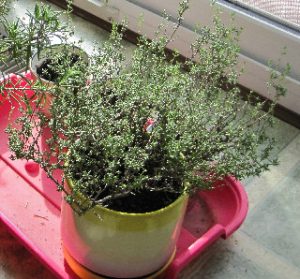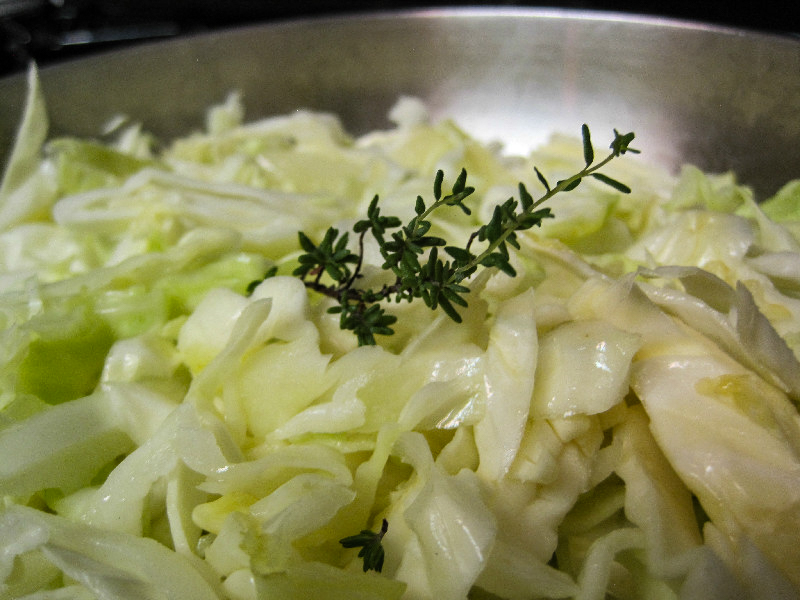Thyme is a perennial shrub that is grown in several places in the world.
The picture above was taken in the hills behind Nice, above the medieval village of Tourettes-sur-Loup. The thyme plants are the low greyish-green mounds. Standing at this particular spot, you can see the Mediterranean. The coast is just 14 km away. What a lovely view for the thyme!
The cuisine of this region is Provençal, specifically Niçoise.
Growing thyme

The plant stays compact, within 6 to 10 inches, not like those other houseplants which grow and grow. Which is not to say that you can keep thyme in a plant pot forever. The guidance from the gardening community suggests that after three or four years it will become woody and you’ll want to replace it. I’ve had mine for three years, and I’m still happy with it.
Think Mediterranean–higher elevations, in rocky terrain. Warm days, cooler nights. Plant in well-drained soil, that is, include some coarse sand and humus.
Do water it enough–it’s not a desert plant–but let it dry out in between waterings. Don’t over water or it will rot.
Thyme prefers full sun.
Species and varieties
There are around 350 species of thyme. The common culinary variety is Thymus vulgaris.
Lemon thyme Thymus x citriodorus, is not as versatile, but it’s wonderful when added to a pot of steaming vegetables or boiling potatoes. My lemon thyme plant is remarkably hardy. It comes back bigger and stronger every year in my garden, and I live in Zone 3.
Using thyme

It doesn’t take a large quantity of thyme to make an impact on your cooking.
- Harvest a few twigs by snipping close to its base.
- Swish in warm water to clean them.
To use the thyme in a soup, a stew, or in sauteed vegetables, add the twigs at the start of the cooking process. Don’t bother removing the leaves–just throw the whole thing in. Very often the leaves will fall off in the cooking process. Before serving, remove the twigs.
Science and Lore
Twelve essential oils, the main one being thymol, were identified in Thymus vulgaris growing in the wild in northern Italy.
Thyme has been used for centuries for flavouring as well as medicinal, spiritual, and fumigatory properties.
From Herbs for the Home and Garden by Shirley Reid (1989, Angus & Robertson, Australia):
“There are many legends about thyme. Associated with death, it was used as a fumigant after sacrifice and at funerals and was frequently planted on Welsh graves. Those belonging to the Order of Oddfellows carry sprigs ant funerals and these are tossed into the open grave of a deceased member…
Thyme was beloved by fairies and in the Ashmolean Library, Oxford, there is a seventeenth century recipe for a potion ‘To enable one to see the Fairies’.”
The book also contains an excerpt from The Useful Plants of Great Britain (1862), where C. Pierpoint Johnson wrote the following:
“In France a decoction of the plant has been successfully used to cure the itch, and some other skin disorders. Linnaeus recommends it for relieving headache cause by ‘the effects of intoxication’….There can be no doubt that to this and other aromatic herbs much of the superiority of flavour in the flesh of sheep, fed upon down land, is due; for though many have denied that these animals ever eat these strongly flavoured plants the fact is perfectly well known to all who have had an opportunity of observing them feeding on hill pastures, where the Thyme and Marjoram abound, those herbs always being cropped close when growing with grass.”